Passing the Test
This reflection on some of the key themes and motifs in the films of Howard Hawks is presented in conjunction with a complete Hawks retrospective at Museum of the Moving Image, from September 7-November 10, 2013.
"Shall I count to three like they do in the movies?”
There will be a test. This is one of the certainties in the films of Howard
Hawks, but the tests come in many unexpected guises. They might be as easily
overlooked as an oddball question (“Were you ever bit by a dead bee?”), or as
daunting as the task of tracking a killer into a saloon full of enemies. When,
in The Big Sleep, Marlowe (Humphrey Bogart) confirms that the address
little Harry Jones (Elisha Cook, Jr.) gave to a thug just before he was killed
is a false one, he smiles with relief and personal satisfaction: Jonesey has
passed the test.
In a career stretching over almost half a century, Hawks made movies in every
genre about the same subject: how people bond through shared ideals of
behavior. These ideals have something to do with courage, something to do with
honor and honesty, but they also have a lot to do with how you light your
cigarette and whether you get the joke, how well you sing and how you look when
you cross a room. Hawks’s best people are always performing for each other and
appraising each other’s performances. It is as if they know they are in a movie,
where style counts because, after all, there is nothing behind the surface of
the screen.
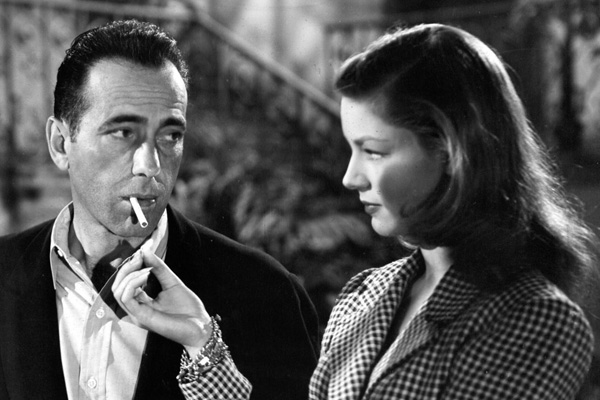
To Have and Have Not
“You don’t have to act with me, Steve.”
In To Have and Have Not (1944), Hawks took a conventional
action-adventure plot (very loosely adapted from a book Hawks described to its
author, Ernest Hemingway, as “that piece of junk,” but more closely patterned
on the previous year’s Casablanca), and used it purely as a framework
for people watching each other’s behavior. Humphrey Bogart gives a definitive
performance as an observer; what he chiefly observes is Lauren Bacall’s
definitive performance as a performer, whose visible effort only enhances the
effect. The magnificence of her lithe, angular movements, drawling bassoon
wisecracks and smoldering, up-from-under glances is in no way diminished by
traces of nerves and awkwardness. Instead, the vulnerability under her bravado
makes us like her more, and root for her as she carries it off. Bogart’s
character, Harry Morgan, may be stand-offish with Bacall’s “Slim,” playing hard
to get; but the actor is all generosity as he allows the inexperienced
thoroughbred to upstage him. He backs her up with his marvelously precise
reactions: little lifts of the eyebrows, widenings of the eyes, and slight
smiles, the appreciative warmth banked down behind his weathered deadpan. It is
she who delivers the famous whistling line, but he silently recapitulates it,
considering the words and then trying out a thoughtfully impressed
wolf-whistle.
A down-on-his-luck fishing boat captain in Martinique, Harry Morgan is acutely
observant with everyone; it is his essential stance. His observations can be aggressive
(the way he notices and needles the police henchman who never talks), or wary
(his alarmed sidelong glance when Madame De Brussac glowingly tells him he cannot
make her angry). They can also be supportively amused, his usual reaction to
Eddie (Walter Brennan), his comic rummy sidekick. All the “good” people in the
film are attentive and observant; this is what Eddie’s “dead bee” question is
really about. The people who impatiently insist they have never been bitten by
any kind of bee are the ones who are wholly caught up in their own illusion of
dignity, and uninterested in figuring anyone else out. The people who pass the
test are the ones like Slim—always watching in the background with her chin
tucked and her eyes raised—who respond with a question (“Were you?”), taking an
interest in Eddie instead of brushing him away.
This perpetually sidelong, commenting stance, whereby even a kiss is set up as
something to be sampled (“I’ve been wondering whether I’d like it”) and
appraised (“It’s even better when you help”), can easily become judgmental.
When Harry thinks that Slim has faked her homesick tears he sneers, “You’re
good,” exactly as Bogart’s Sam Spade said of the chronically deceitful Brigid
O’Shaughnessy in John Huston’s The Maltese Falcon (1941). He assumes
that everything is a performance, commenting that it “takes a lot of practice”
to absorb a slap in the face without flinching. But Slim is not so “good” or
practiced a performer after all; for all her chutzpah, she is not always in
control. She really does break down and cry, and she cannot help showing her
jealousy and uncertainty. Between Harry and Slim there is, after all, a gulf of
age and experience. Knowing how long it took the 45-year-old Bogart to shed his
own awkwardness and develop his repertoire of gestures, his potent minimalism
and his supremely assured presence adds something touching to his appreciation
of nineteen-year-old Bacall’s quick learning, how well she imitates his own insolent
confidence.
Already stylized and rhythmic, placing sound above sense, the Hawksian
performance slips easily into music. When Slim steps in to join Cricket (Hoagy
Carmichael) singing “Am I Blue?” it is partly to get away from the odious
Johnson, partly to throw another come-on at Harry, and partly just because she
digs the music. There is a beautiful moment as the band begins to play, when
the camera glides through the musicians so that the image opens out as the
sound opens out, inviting us in. Cricket, who never moves from his piano stool,
is the film’s presiding spirit, an observant performer. Take his wonderful
reaction of surprised approval when he hears Slim’s voice; or his askance,
embarrassed reaction to the rather chunky girl who leans adoringly on his piano
during “Hong Kong Blues,” clumsily throwing her hips around. He creates the
setting for Slim’s supreme performance in “How Little We Know,” with its slinky
temple-dance rhythm and lyrics that wryly accept uncertainty and forgo the love
song’s traditional demand for promises. This performance has a large and doting
audience but is really for one person alone, and Harry completes it by granting
her, for the first time, his unqualified approval.
Many of Hawks’s women are professional singers or entertainers: Barbara
Stanwyck in Ball of Fire, Jean Arthur in Only Angels Have Wings,
Marilyn Monroe and Jane Russell in Gentlemen Prefer Blondes. Musical
numbers in Hawks are almost invariably terrific, but best of all are the
intimate, casual ones where people sing to each other in private. In Scarface (1932), the brief wedded bliss of Cesca (Ann Dvorak) and Guino (George Raft) is
summed up as she sits at the piano playfully serenading him with “The Wreck of
the Old 97,” a jaunty song about a fatal train crash that perfectly suits her
reckless, flammable charm.
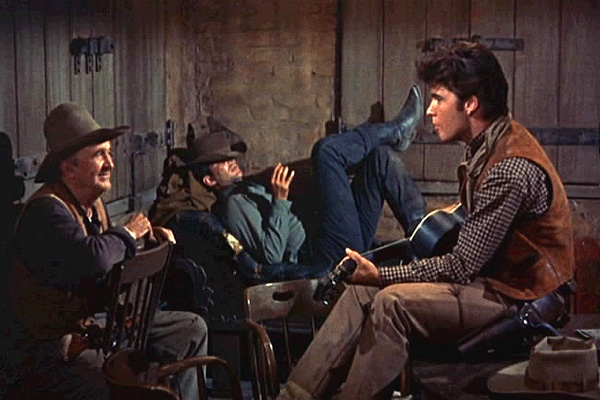
Rio Bravo
These musical interludes express the peculiar coexistence or interdependence of
individuality and communalism in Hawks’s movies; they are opportunities for the
purest performance of the self and for the warmest social bonding. When Dude
(Dean Martin) sings in Rio Bravo, lying on his back with his hat over
his eyes, it is so gratifying to hear his molasses-smooth, effortless crooning
because up to this point in the film we have seen only his suffering and
struggle, his shakes and cramps and irritable rages and self-loathing sulks.
Suddenly we see him transformed, and we see that he has something—not just a
beautiful voice but a relaxed ease—that his best friend Chance (John Wayne) can
never have. When Dude, Colorado (Ricky Nelson) and Stumpy (Walter Brennan) all
sing together on the rousing “Cindy,” Chance does not join in but looks on
smiling. John T. Chance is another observer, though of a very different kind
from Bogart’s Harry Morgan. Mostly what he watches is Dude as he passes through
the purgatory of withdrawal from the bottle. He reacts with worry, annoyance,
responsibility, pride, disgust, many subtle shades of repressed sympathy.
Chance is the character whose approval everyone seeks (“I never can please you!” Stumpy constantly complains), whose competence and authority are
unquestioned, yet he is also perpetually caught up—in his tetchy, baffled way—in
the doings of his friends.
Rio Bravo (1959) was, in part, Hawks’s rejoinder to High Noon (1952). The earlier film, written by blacklistee Carl Foreman, is an austere portrait of a craven society where no one is willing to stick out his neck, except the isolated sheriff who grimly does his duty before dropping his badge in the dust. Hawks said he wanted to show how a real, professional lawman would act, and he pointedly included a scene where Chance declines an offer of help from a man who is not “good” enough to be of use. But the real difference between the movies is the difference between a political vision of social responsibilities, and an apolitical vision that values purely personal ties. Rio Bravo is no more about the conflict between lawmen and outlaws than To Have and Have Not is about the conflict between the Vichy government and the Free French. It’s about friendship, and about a kind of aristocracy of character; Hawks’s movies make no bones about the fact that some people are better than other people.
The whole film spins out from a riveting wordless prologue; it includes the
killing and arrest that set off the film’s ostensible plot, but they are
afterthoughts. The focus is on the first encounter between Dude and Chance: the
pained disgust with which the sheriff looks down at his old friend groveling
for the price of a drink, and the blind fury with which the drunk lashes
out—both because he’s been deprived of his drink, and perhaps because he cannot
stand being seen in such a humiliating position. It looks like the end of a
friendship, but instead it is the start of a reunion.
Here, more than ever, Hawks lets us luxuriate in just being with these people
and enjoying their enjoyment of each other, peppered as it is with bickering,
teasing, and painful episodes of disappointment and anger. Dramatizing ongoing
friendship is probably no easier than dramatizing marriage: the usual method of
depicting a lasting relationship is to cover a long period of time and
highlight major events. Here instead we get everyday moments of pettiness and
fun: Stumpy sweeping up the jail and complaining that no one appreciates him, Chance
planting a kiss on top of his head and the outraged Stumpy whacking him in the
rear with his broom. Dude is pitifully jealous of the young gunslinger Colorado
(“Is he as good as I used to be?”), and after Stumpy almost kills Dude
accidentally, they are all angry the way parents get angry when their children
run out in the street. The bad guys are smart enough to know that the way to
defeat this little group is through each other—their loyalty is their greatest
vulnerability, but it is balanced by their greatest strength: how much they want
to measure up in each other’s eyes.
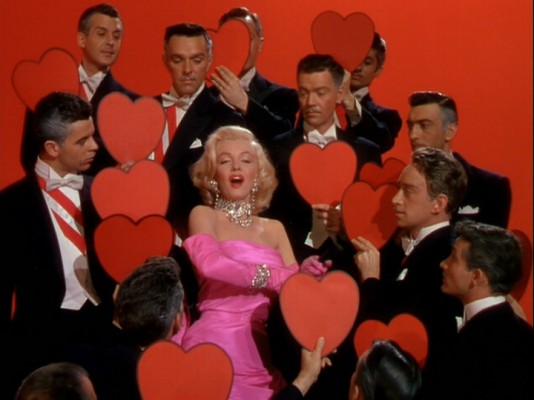
Gentlemen Prefer Blondes
It is no surprise that Hawks should make such a triumphant celebration of
masculine friendship, but he also made one of the greatest—and least
likely—celebrations of female friendship in Gentlemen Prefer Blondes (1953). It is unlikely because Marilyn Monroeg Lorelei Lee, the rapacious and
apparently feather-brained blonde bombshell, seems like the kind of woman who would
be disliked by other women as much as she is preferred by gentlemen. But Hawks
pulls off something remarkable here, presenting his two heroines as almost
cartoonish caricatures of sexy femininity, and at the same time hewing entirely,
and respectfully, to their point of view. No other director really emphasized
Jane Russell’s brain over her bosom (not that Hawks slights the latter), and
she is a revelation as the smart, dry, warm-hearted Dorothy, who deplores
Lorelei’s obsession with jewelry and willingness to play up to men to get it,
yet remains staunchly loyal to her. When the two women sing together,
especially in the charming, bluesy “When Love Goes Wrong, Nothing Goes Right,”
they embody perfect harmony and platonic chemistry. When, in the end, Dorothy
impersonates Lorelei, wearing a platinum wig and imitating Monroe’s breathy,
little-girl voice, it could be condescending, even cruel, yet instead it comes
off as both an act of solidarity and a delicious joke. As for Monroe, she
somehow both inhabits and transcends Lorelei’s solemn silliness, touching
lightly but incisively on the way Lorelei believes herself to be the sensible
realist to Dorothy’s irresponsible romantic.
So many actors were never better than under Hawks’s direction. No doubt this is
largely because he cared more about characters than anything else, and built
movies around the talents of particular stars. But it also has something to do
with the strange connection in his films between the most polished artifice and
the deepest authenticity. The young John Wayne practiced his postures and
movements in front of the mirror; Bogart learned to use a vocabulary of
idiosyncratic gestures to construct a screen persona; Cary Grant famously
admitted he “pretended to be someone I wanted to be until I became that
person.” There is a difference between pretending to be something you want to be
and pretending to be something you’re not. In Hawks’s movies, the boundary
between an actor’s performance and the performance of his or her character is
often unclear. The actors are reciting lines; the characters may be putting on
an act, or even telling lies. None of this means they are not also being true to
themselves.
“I never thought I should stoop so low as to become an actor.”
Hawks’s people bond through shared ideals of behavior, but he also framed couples
who are so much alike in their behavior that they can neither stand each other
nor stay apart. Such couples appear in Twentieth Century (1934) and His
Girl Friday (1940), both written by or based on the work of Ben Hecht and
Charles MacArthur. The films share a basic premise (a man tries to win back a
woman who is both a professional protégée and an ex-lover), and they also share
a delirious, word-drunk obsession with rhetoric, persuasion and fakery.
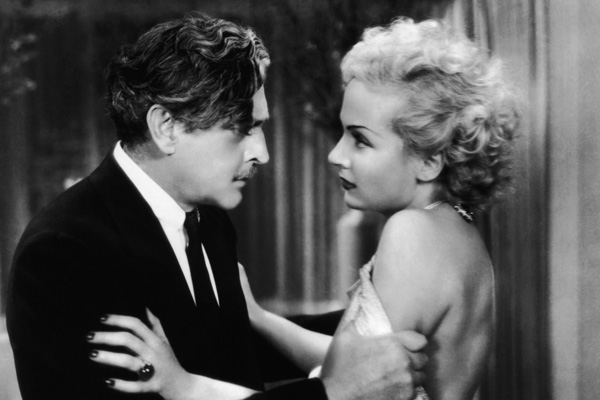
Twentieth Century
Twentieth Century proves the truism that only very good actors can play
really bad actors. As director Oscar Jaffe, John Barrymore’s hamminess is
knowing, calibrated, hilarious—but it is also genuinely and juicily hammy, an
expression of true delight in the indulgence of dramatic excess. Carole
Lombard’s performance as actress Lily Garland is much more varied and
quicksilver in its transformations, from awkward, wide-eyed amateur to
posturing diva who throws tantrums and in the same breath announces that she
hates temperament. Her gloriously phony histrionics are interspersed with
spontaneous kinetic inspirations, like the famous kicks she aims at Barrymore’s
abdomen or the way she appears in a doorway, eyes blazing, arms akimbo, totally
unself-conscious in her underwear. Oscar Jaffe and Lily Garland spend the whole
movie accusing each other of being fakes, which of course they both are. After
sneaking aboard a train in the guise of a Kentucky colonel, Jaffe laments that
he has “stooped so low as to become an actor”—this from a man who cannot
describe the trappings of a biblical epic without pausing to mimic a camel. As
for Lily, when her boyfriend reacts to her movie-star hysterics by sneering,
“Oh, an artist,” she snarls back, “Yer darn tootin’ I am!”
In the end, Jaffe successfully snookers Lily by pretending he’s dying, getting
her to sign a contract seconds before he’s exposed as a fraud. The film ends as
it began, with the two in a stage rehearsal, but without reuniting them
romantically. Surely no one but Hecht and MacArthur—and Hawks—would dare to
present, in a comedy, a man and woman who are both such a convincing couple,
and such a convincingly disastrous one.
Unlike Ben Hecht, Hawks was not cynical—he was unsentimental. When, in a stroke
of genius, he changed the sex of reporter Hildy Johnson in Hecht &
MacArthur’s newspaper drama The Front Page, he managed to turn the
quintessential hard-boiled comedy into a completely satisfying love story
without softening it at all. Newspaper boss Walter Burns (Cary Grant) is the
most shameless, flamboyant, and successful of liars. He can even fool Hildy
(Rosalind Russell), who as his ex-wife and ex-employee knows just what he is.
She still falls for the ardent speech with which he persuades her that she can
overturn a corrupt city government (“They’ll be naming streets after you!”),
just as the guileless Bruce Baldwin (Ralph Bellamy) falls for his heartbroken
act—he wipes a tear away, then taps Bruce on the shoulder to make sure he sees
it. Whenever Hildy realizes she has been caught she blasts Walter with her
outrage, but she revels in his wiles too—listening with gloating enjoyment as
he sweet-talks the poet Benzinger, knowing full well that the poor chump will
get the works. Walter’s insincerity is so fervent, so inspired, that it is a
kind of truth. He is, as Hildy admits, “wonderful, in a loathsome sort of way.”
The film’s romantic epiphany hinges on Hildy’s relief when she realizes Walter
was faking his sober, sincere insistence that he is ready to let her go. “What
do you think I am, a chump?” he retorts, and this is the way he tells her that
he loves her. He proves his love by having her fiancé arrested for carrying
counterfeit money. He is utterly unregenerate, as insensitive and shameless in his
last words (“I wonder if Bruce can put us up?”) as in his first, but Hildy
knows that her authentic self lies with him, in the callous, scrabbling,
adrenaline-pumping life of a newspaperman. Besides, who could resist a man who
would confront a divorce suit by hiring a pilot to sky-write “Hildy do not be
hasty, remember my dimple”?
Unlike the cool, observant couple in To Have and Have Not, Walter and
Hildy are often blissfully oblivious of others: Walter brushes people away as
if they were gnats, and Hildy blithely ignores Bruce’s earnest ultimatum while
she hammers away at her typewriter. They are, in the end, both literally and
figuratively handcuffed together: no one else would put up with them.
Oscar and Lily, Walter and Hildy are evenly matched: they can give as good as
they get in their chosen field of battle, their eternal game of fooling and
being fooled. In other films, lies are more damaging. Gary Cooper’s Professor
Potts is deeply wounded when he realizes how he has been tricked and used by
Stanwyck’s Sugarpuss O’Shea in Ball of Fire (1941; a film dominated by
the fabulous verbiage of its Billy Wilder-Charles Brackett script). Bogart’s
Philip Marlowe keeps Bacall’s Vivian Rutledge at arm’s length because he knows
she is lying to him, and he is determined to dig up the truth and rescue her
despite her unwillingness to be helped. The Big Sleep (1946) is built on
Raymond Chandler’s baroquely disillusioned view of the world as a swamp of
corruption, but Hawks blithely overlays it with his own dry, tonic, bantering
tone. Scenes like the one where Vivian and Marlowe tease the police over the
phone, or prime each other with racy innuendo (a scene added after previews to
please audiences), act just like the dances in Astaire-Rogers movies, proving
the sublime compatibility of the seemingly mismatched couple.
Chandler, Hecht and MacArthur, Wilder and Brackett were all, in their different
ways, virtuosic masters of American talk: of slangy come-backs, insolent
put-downs, flaming diatribes, potent zingers, grandiloquent speeches, and the
occasional straight shot of hard truth. The importance of physical gestures in
Hawks has often, and rightly, been noted, and he is justly associated with the
masculine realm of action and heroics. Yet the life in his movies comes from the
sharing of a common language. People repeat each other’s lines, answer each
other’s questions, pick up each other’s vocabularies (as Professor Potts learns
slang from Sugarpuss), sing the same songs (“I Can’t Give You Anything But
Love, Baby”) or recite the same poems (“Ride, boldly ride”). But language is
dangerous and unstable too; people use it to trap others, and sometimes they
are trapped and betrayed by their own words.
“Was I all right? Was I what you wanted?”
Hawks’s women, for instance, often fall into a particular kind of panicked
talking jag; they seem unable to stop nervously hectoring a man, wanting some
kind of response but only succeeding in exposing their own insecurity. This is
what happens when performance fails, when the “unbroken series of successful
gestures” (as Nick Carraway defines personality in The Great Gatsby)
breaks down. You can sense the women trying to carry off an independent bravado
and suddenly realize they are too far out on a limb, uncertain and clutching
for reassurance. It happens to Angie Dickinson in Rio Bravo, to Jean
Arthur in Only Angels Have Wings, even to Slim, worrying that Harry
disapproves of her golddigging. At extremes women become ridiculous, like
Joanne Dru in Red River (1948), pestering Montgomery Clift while he is
busy repelling an Indian attack; or pathetic, like Paula Prentiss in Man’s
Favorite Sport? (1964), who collapses into full-fledged hysteria after
badgering Rock Hudson to kiss her.
The common complaint about Hawks’s women has always been that they are required
to act like men in order to be accepted; they often recall little girls
pleading to be allowed into the tree house and promising they wouldn't do anything
girly, like cry. On the other hand, Hawks’s attitude is a welcome departure from
the traditional romantic premise that women are desirable objects simply
because they are beautiful; they do not have to do anything, they are merely
prizes to be won by men, who must court them or prove themselves worthy through
action. Hawks’s women are always attractive, but that’s not enough; they also
have to show character and relate to men on some level of equality.
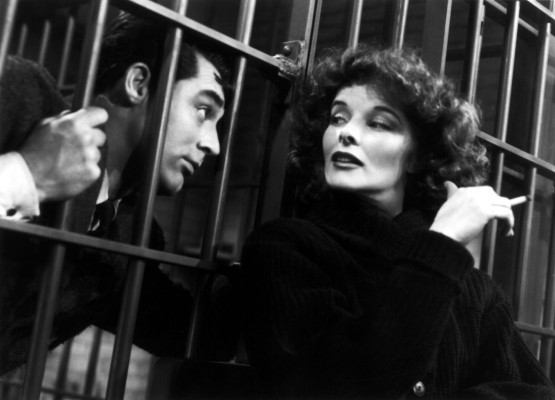
Bringing Up Baby
Nonetheless there is, to my eye, something rather cruel about the way Hawks forces
women to aggressively pursue men without granting them the kind of invincible
self-confidence that allows Marlene Dietrich or Mae West to go on the offensive
without any risk of making fools of themselves. There are exceptions: Katherine
Hepburn in Bringing Up Baby (1938) is invulnerable by virtue of her Olympian
kookiness, her cat-like incapacity for shame or embarrassment. Women like Hildy
and Sugarpuss are not invulnerable, but they are wised-up professionals with
too much experience and control to trip themselves up.
Then there is Jean Arthur waving a gun around and accidentally shooting Cary
Grant; Angie Dickinson donning tights in a last-ditch attempt to get John Wayne
to admit he wants her; Paula Prentiss huddled in the woods sobbing, having
driven away the man she wants through her hopeless confusion of sexual need and
sexual terror. “Was I all right? Was I what you wanted?” Lily Garland anxiously
asks her Svengali director after her first stage performance. It is the need to
be what somebody else wants, to perform correctly, to pass the test, that leads
to these breakdowns and outbursts of flustered awkwardness. These moments are
painful, and it seems unfair that only women are subjected to them, but they
are also realistic. These failures and breakdowns make the successful gestures,
the shared ideals of behavior, more powerful and more moving. These cracks in
the smooth surface connect the remote, stylized glamour of the movies with the
nerve-wracking, humiliating stumbles of real life.
It is here that the two sides of Hawks’s cinema meet: the cool competence of
Bogart and his Hemingway-esque realm of graceful professionalism; the flustered
haplessness of Cary Grant in the face of endless comic assaults on his dignity.
Whole movies are dominated by frenetic energy, hectic pacing and high blood
pressure (“There haven’t been any quiet moments”), or by easy-going, steady,
get-the-job-done rhythms (“Let’s take a turn around the town”). One quality is
learned, practiced, deliberate; connected to professional skill, maturity and
formal rank. The other is spontaneous, instinctive, uncontrolled, linked to
nature and infancy. They are, in some strange way, equally essential to the
Hawksian spirit.
“She’s making all this up out of motion pictures she’s seen!”
“Does it work the second time?” Slim asks sarcastically, after repeating
Madame De Brussac’s lines to Harry Morgan (“I don’t think I’ll ever be angry
again with anything you do”), vigorously batting her eyelashes. Hawks obviously
believed that things work the second time: not only do people in his movies
repeat recurring lines, he also recycled lines, entire scenes and plots from
one film to another. The answer to Slim’s question, however, is clearly:
sometimes.
“I heard you the first time,” Hildy tells Bruce after he pays her a compliment,
“I liked it. That’s why I asked you to say it again.” Minutes later she accuses
Walter of repeating himself: “That’s the speech you made the night you
proposed...’Course I remember it: if I didn’t remember it I wouldn’t have
divorced you.”
Repetition is a strange thing. Children adore it. We all hate to hear other
people repeat themselves, yet enjoy repeating our own favorite stories and
lines. Practice—repetition—is necessary to achieve perfection, yet culturally
we place a premium on originality. There are improvised moments in Hawks—he
expressed his delight when Mitchum in El Dorado (1967), wedged into a
small galvanized tub, spontaneously reacted to a woman’s entrance by modestly
covering his eyes with his hat. El Dorado is neither better nor worse
than Rio Bravo, but it is strikingly different, despite all the
similarities in plot and characters. On the other hand, when the torn-dress
scene from Bringing Up Baby is re-enacted in Man’s Favorite Sport? it has none of the original’s dazzle, it just goes through the motions and tacks
on a conventional bedroom-farce punchline. But when Angie Dickinson slightly
recasts Jean Arthur’s line, “I’m hard to get, all you have to do is ask me,” as
“I’m hard to get. You’ll have to say you want me,” she is refining the meaning:
the woman is not saying she is easy, but insisting that the man outgrow his
complacent passivity.
Hawks’s people pick up on lines and repeat them, whether mockingly or as a
means of bonding, the same way audiences copy bits from movies. We all
construct personas by trying to imitate things we like—human beings are
hard-wired to learn by copying, mirror neurons driving our Hawksian delight in
social bonding, language and interpretation of physical gestures. When Cary
Grant says that Bruce looks like “that fellow in the movies, Ralph Bellamy,” or
reacts to Hepburn’s brilliant, lunatic impression of a gangster’s moll by
fuming, “She’s making all this up out of motion pictures she’s seen!” it
is doubly funny because of Grant’s consciousness of himself as a constructed
persona, a dream that could be realized only on a movie screen.
Hawks’s people are ravishing, but rather than presenting them as deities far
beyond our reach, he lets us sometimes see them working at it, and even
worrying about how they are doing. Even in the movies, it seems, people want to
be more like the movies. There is a great deal of comfort in that.
![]()
LATEST ARTICLES
-20140814-173707-thumb3.jpg)
Fighting Words
by Imogen Sara Smith
posted August 12, 2014

Fighting Words, Part 2
by Imogen Sara Smith
posted August 20, 2014

On the Margins: The Fil…
by Andrew Chan
posted August 12, 2014

Robin Williams: A Sense…
by David Schwartz
posted August 12, 2014
 Passing the Test
Passing the Test
THE AUTHOR
Imogen Sara Smith is a writer living in Brooklyn. She is the author of two books, In Lonely Places: Film Noir Beyond the City and Buster Keaton: the Persistence of Comedy.
More articles by Imogen Sara Smith
